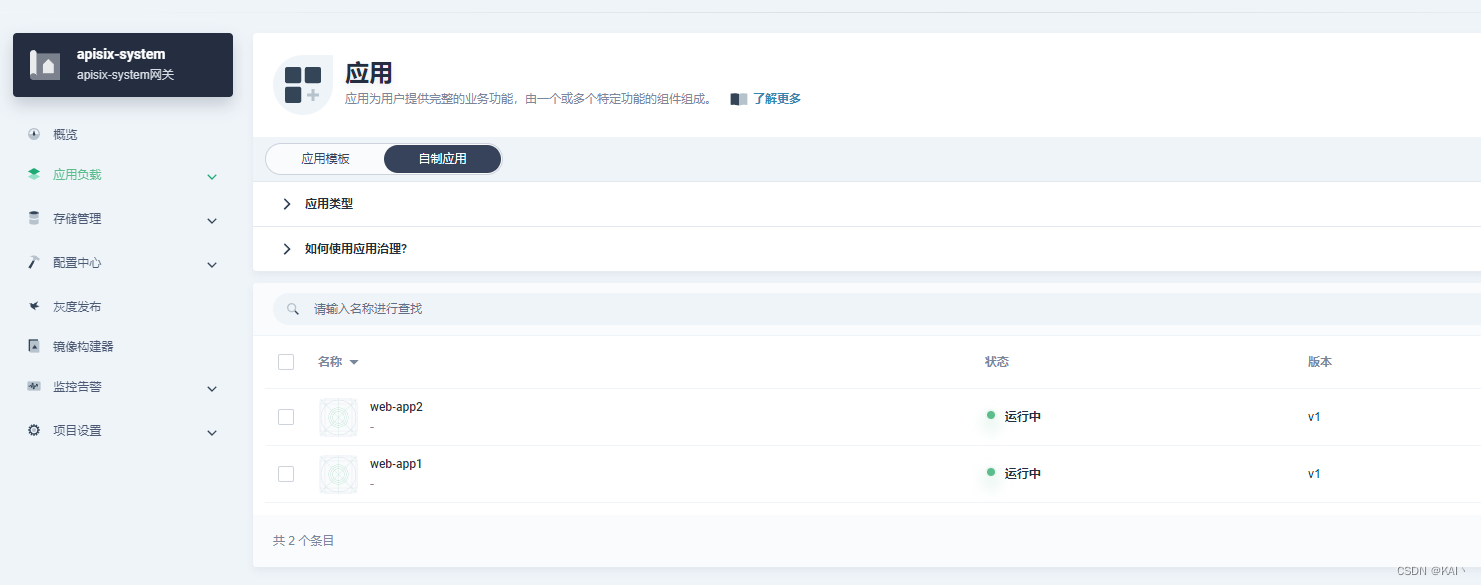- 1【Android】安装Android Studio遇到Unable to access Android SDK add-on list的错误导致无法选择SDK_andorid studio unable to access android sdk add-on
- 2基于SpringBoot+Vue+ElementUI+Mybatis前后端分离管理系统超详细教程(三)
- 3AWS Lambda结合Android应用的初次尝试_aws toolkit android studio lambda java aws
- 4石头剪刀布python代码_Python剪刀石头布编程思路
- 5pycharm连接数据库显示could not to creat conection to database server_python jedi client: couldn't create connection to
- 6【kotlin】在SpringBoot项目中使用kotlin协程coroutine实现方法的异步延迟调用,例如延迟查询短信发送详情结果。
- 7【Minecraft】在Linux上架设我的世界Minecraft服务器(保姆级教程)_linux搭建mc服务器
- 8Ubuntu+Stm32cubeMX+vscode+stlink开发_linux stm32cubeide 链接stlink
- 9连接过来的设备的信息存放_/data/misc/dhcp/dnsmasq.leases
- 10VCL组件DevExpress VCL v21.1 - 全新的甘特图控件_devexpressvcl
【kubernetes】k8s部署APISIX及在KubeSphere使用APISIX_apisix k8s
赞
踩
Apache APISIX
https://apisix.apache.org/
功能比nginx-ingress更强
本文采用2.5.0版本
https://apisix.apache.org/zh/docs/apisix/2.15/getting-started/
概述内容来源于官方,学习于马士兵云原生课程
概述
Apache APISIX 是什么?
Apache APISIX 是 Apache 软件基金会下的云原生 API 网关,它兼具动态、实时、高性能等特点,提供了负载均衡、动态上游、灰度发布(金丝雀发布)、服务熔断、身份认证、可观测性等丰富的流量管理功能。我们可以使用 Apache APISIX 来处理传统的南北向流量,也可以处理服务间的东西向流量。同时,它也支持作为 K8s Ingress Controller 来使用。
主要特性
- 多平台支持:APISIX 提供了多平台解决方案,它不但支持裸机运行,也支持在 Kubernetes 中使用,还支持与 AWS Lambda、Azure Function、Lua 函数和 Apache OpenWhisk 等云服务集成。
- 全动态能力:APISIX 支持热加载,这意味着你不需要重启服务就可以更新 APISIX 的配置。请访问为什么 Apache APISIX 选择 Nginx + Lua 这个技术栈?以了解实现原理。
- 精细化路由:APISIX 支持使用 NGINX 内置变量做为路由的匹配条件,你可以自定义匹配函数来过滤请求,匹配路由。
- 运维友好:APISIX 支持与以下工具和平台集成:HashiCorp Vault、Zipkin、Apache SkyWalking、Consul、Nacos、Eureka。通过 APISIX Dashboard,运维人员可以通过友好且直观的 UI 配置 APISIX。
- 多语言插件支持:APISIX 支持多种开发语言进行插件开发,开发人员可以选择擅长语言的 SDK 开发自定义插件。
主要概念
| 概念/组件 | 描述 |
|---|---|
| Route | 通过路由定义规则来匹配客户端请求,根据匹配结果加载并执行相应的插件,最后把请求转发给到指定的上游应用。 |
| Upstream | 上游的作用是按照配置规则对服务节点进行负载均衡,它的地址信息可以直接配置到路由或服务上。 |
| Admin API | 用户可以通过 Admin API 控制 APISIX 实例。 |
部署
本次采用应用仓库部署
添加应用仓库
进入企业空间-应用管理-应用仓库
添加应用仓库charts.apiseven.com
- 1
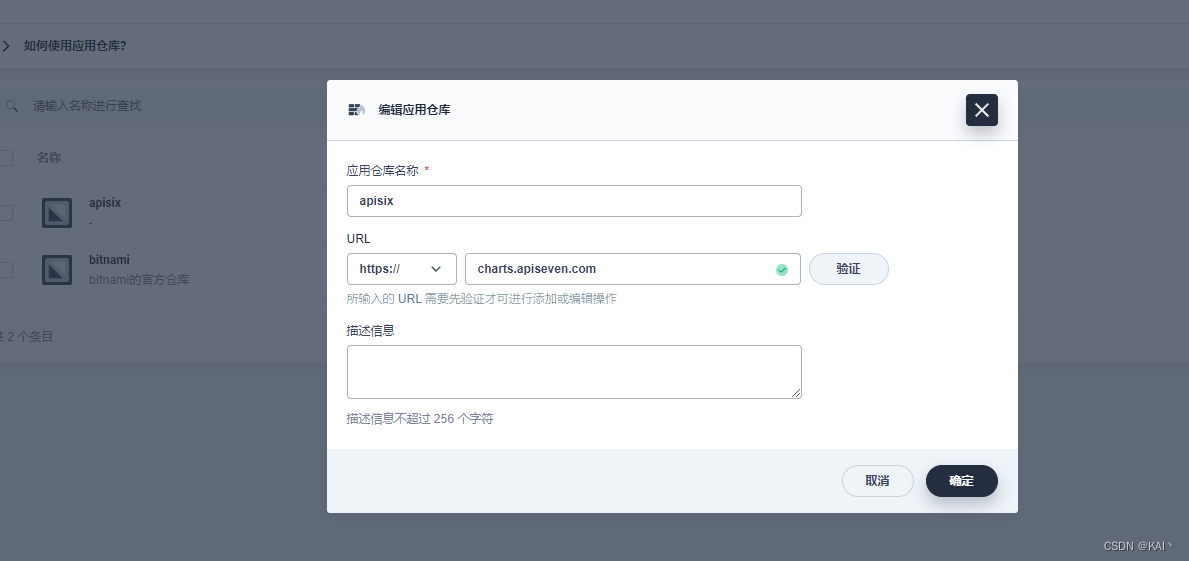
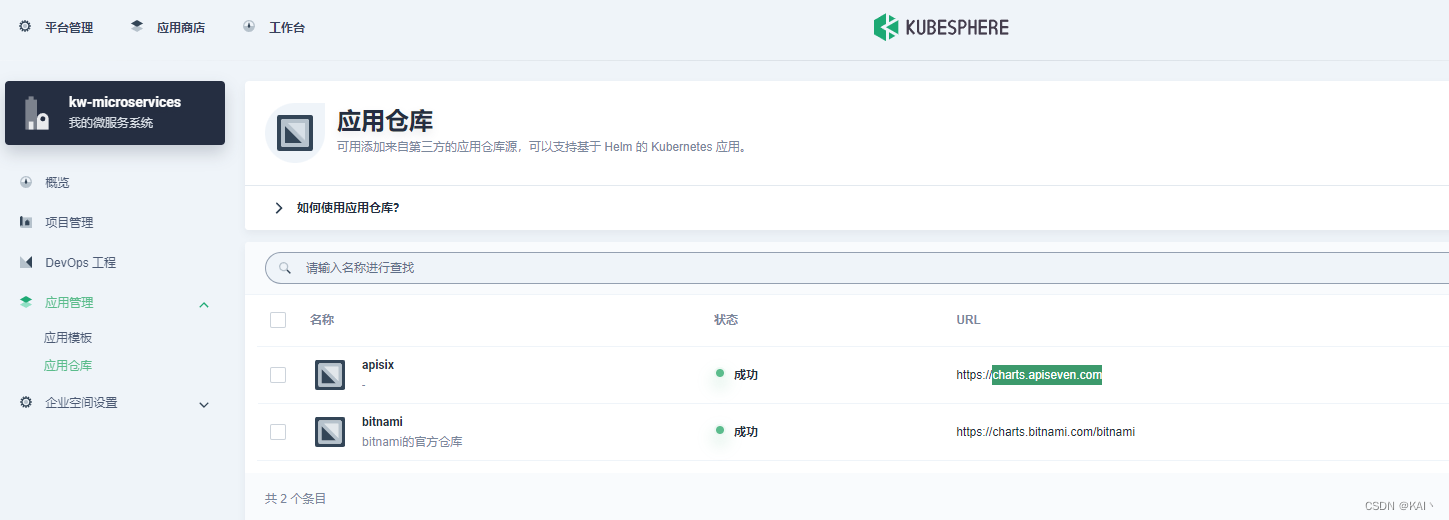
创建项目apisix-system
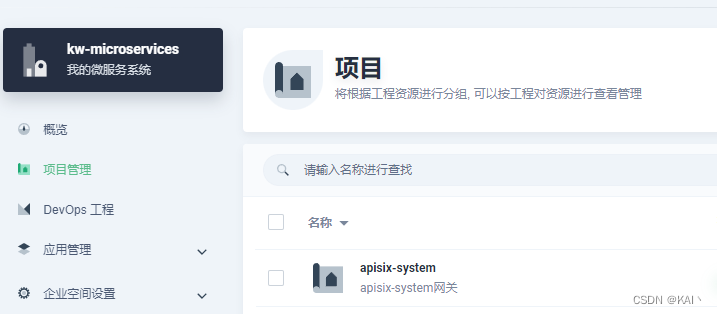
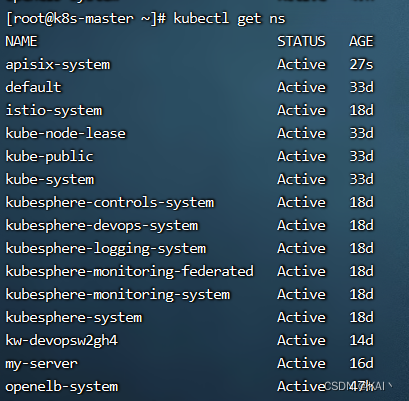
创建应用
进入项目控制台,应用负载-应用
部署新应用-选择应用模板,选择apisix,部署第三个
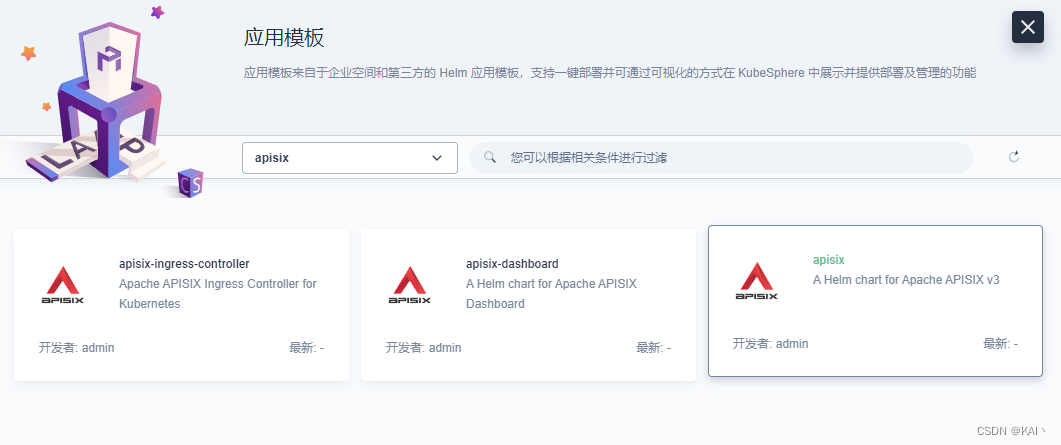
学习阶段,选择视频教程中的版本一致,0.11.2(2.5.0)
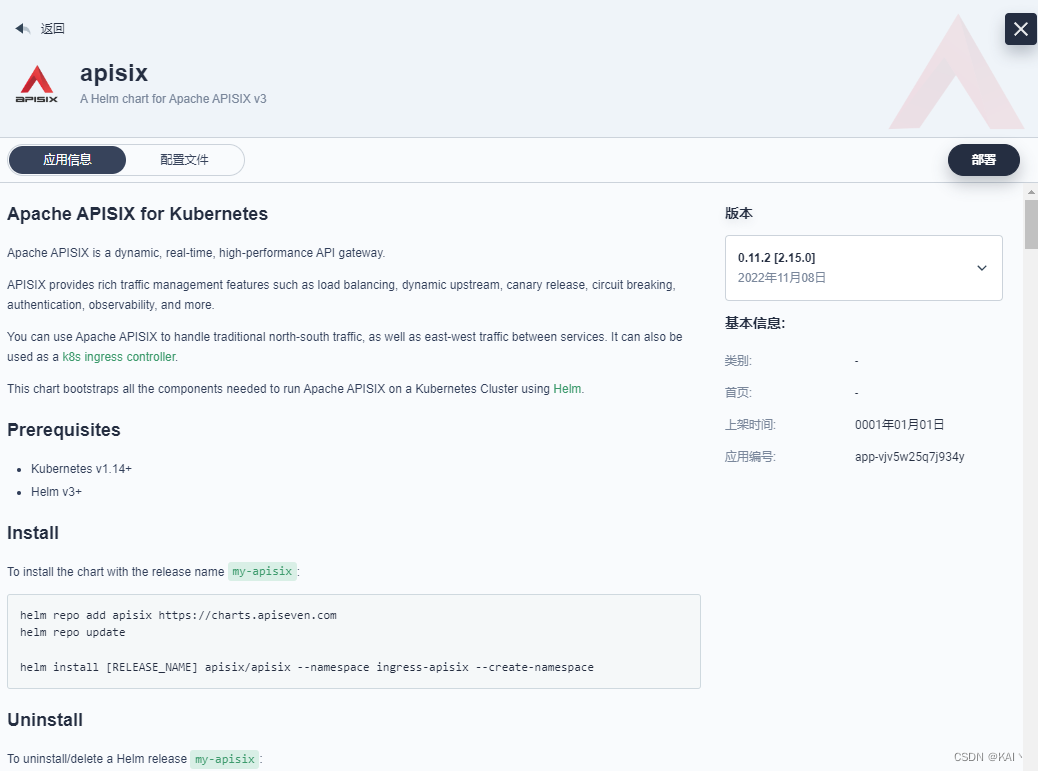
点击部署
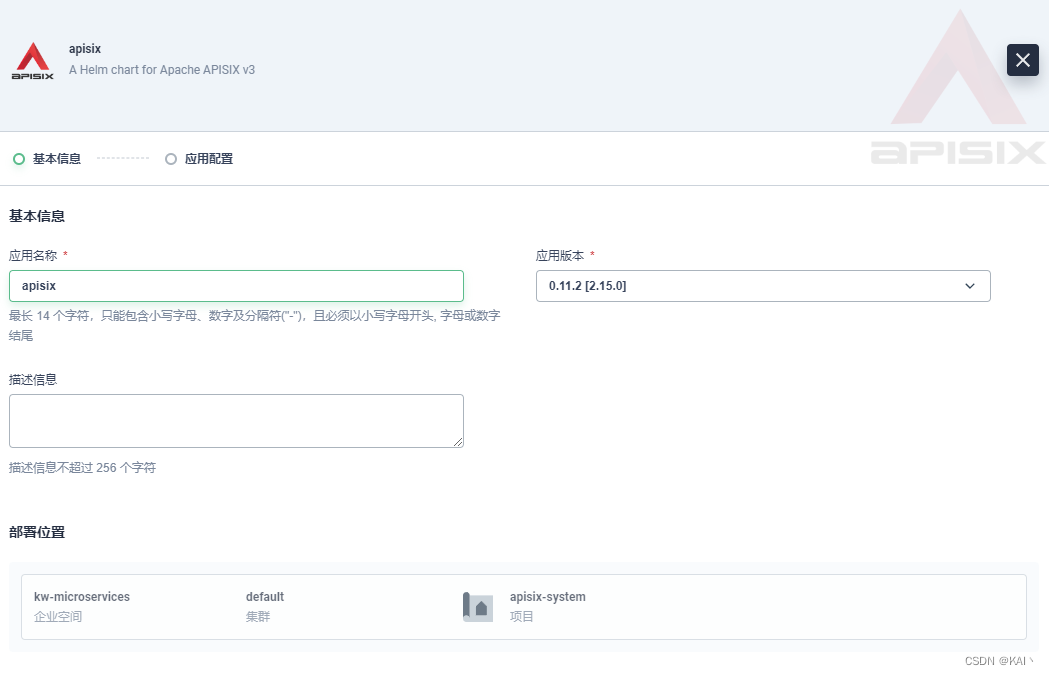
下一步
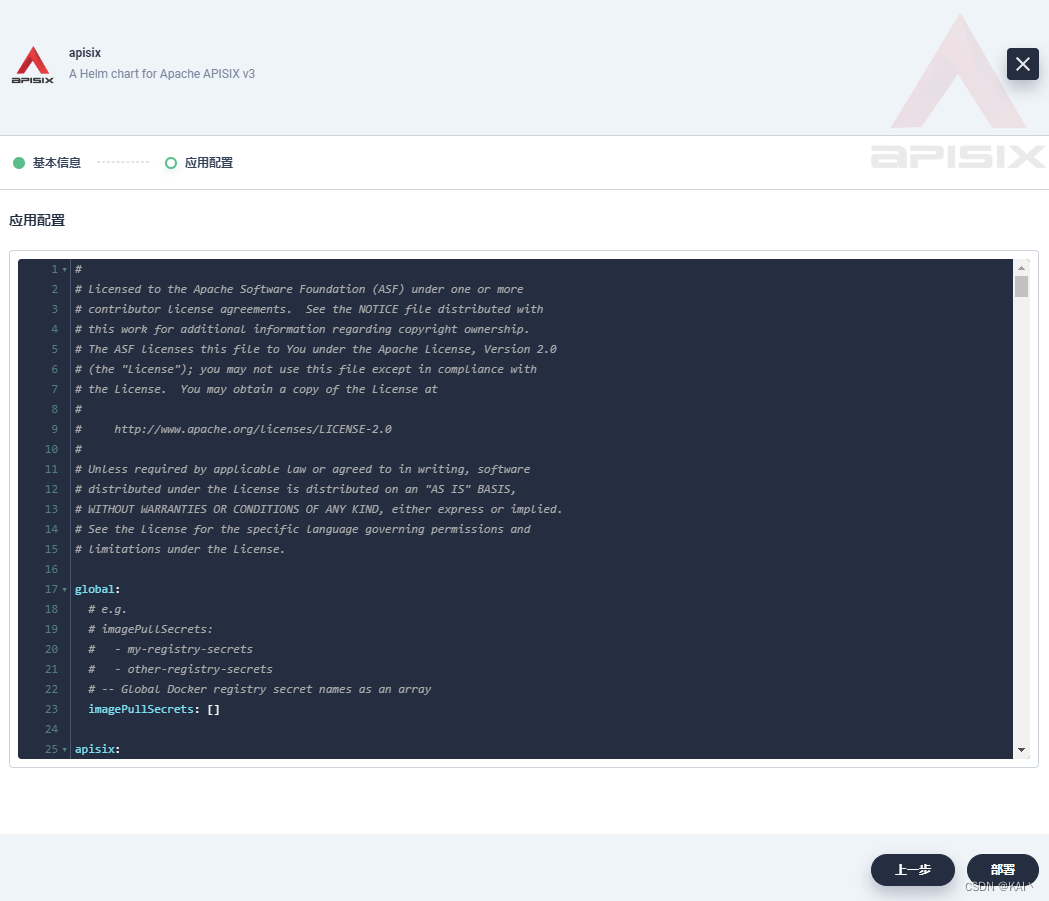
修改配置文件
改动了10处内容,标注了"改动"二字
复制下面内容,覆盖上面的配置即可
# # Licensed to the Apache Software Foundation (ASF) under one or more # contributor license agreements. See the NOTICE file distributed with # this work for additional information regarding copyright ownership. # The ASF licenses this file to You under the Apache License, Version 2.0 # (the "License"); you may not use this file except in compliance with # the License. You may obtain a copy of the License at # # http://www.apache.org/licenses/LICENSE-2.0 # # Unless required by applicable law or agreed to in writing, software # distributed under the License is distributed on an "AS IS" BASIS, # WITHOUT WARRANTIES OR CONDITIONS OF ANY KIND, either express or implied. # See the License for the specific language governing permissions and # limitations under the License. global: # e.g. # imagePullSecrets: # - my-registry-secrets # - other-registry-secrets # imagePullSecrets: [] apisix: # Enable or disable Apache APISIX itself # Set it to false and ingress-controller.enabled=true will deploy only ingress-controller enabled: true # Enable nginx IPv6 resolver enableIPv6: true # Whether the APISIX version number should be shown in Server header enableServerTokens: true # Use Pod metadata.uid as the APISIX id. setIDFromPodUID: false customLuaSharedDicts: [] # - name: foo # size: 10k # - name: bar # size: 1m luaModuleHook: enabled: false # extend lua_package_path to load third party code luaPath: "" # the hook module which will be used to inject third party code into APISIX # use the lua require style like: "module.say_hello" hookPoint: "" # configmap that stores the codes configMapRef: name: "" # mounts decides how to mount the codes to the container. mounts: - key: "" path: "" # Defines how apisix handles routing: # - radixtree_uri: match route by uri(base on radixtree) # - radixtree_host_uri: match route by host + uri(base on radixtree) # - radixtree_uri_with_parameter: match route by uri with parameters httpRouter: radixtree_uri enableCustomizedConfig: false customizedConfig: {} image: repository: apache/apisix pullPolicy: IfNotPresent # Overrides the image tag whose default is the chart appVersion. tag: 2.15.0-alpine # Use a `DaemonSet` or `Deployment` kind: Deployment # kind is DaemonSet, replicaCount not become effective replicaCount: 1 priorityClassName: "" podAnnotations: {} podSecurityContext: {} # fsGroup: 2000 securityContext: {} # capabilities: # drop: # - ALL # readOnlyRootFilesystem: true # runAsNonRoot: true # runAsUser: 1000 # See https://kubernetes.io/docs/tasks/run-application/configure-pdb/ for more details podDisruptionBudget: enabled: false minAvailable: 90% maxUnavailable: 1 resources: {} # We usually recommend not to specify default resources and to leave this as a conscious # choice for the user. This also increases chances charts run on environments with little # resources, such as Minikube. If you do want to specify resources, uncomment the following # lines, adjust them as necessary, and remove the curly braces after 'resources:'. # limits: # cpu: 100m # memory: 128Mi # requests: # cpu: 100m # memory: 128Mi hostNetwork: false nodeSelector: {} tolerations: [] affinity: {} # timezone is the timezone where apisix uses. # For example: "UTC" or "Asia/Shanghai" # This value will be set on apisix container's environment variable TZ. # You may need to set the timezone to be consistent with your local time zone, # otherwise the apisix's logs may used to retrieve event maybe in wrong timezone. timezone: "" # extraEnvVars An array to add extra env vars # e.g: # extraEnvVars: # - name: FOO # value: "bar" # - name: FOO2 # valueFrom: # secretKeyRef: # name: SECRET_NAME # key: KEY extraEnvVars: [] nameOverride: "" fullnameOverride: "" serviceAccount: create: false annotations: {} name: "" rbac: create: false gateway: type: NodePort #改动1 这里先不改,后面改为OpenELB,暴露外网访问 # If you want to keep the client source IP, you can set this to Local. # ref: https://kubernetes.io/docs/tasks/access-application-cluster/create-external-load-balancer/#preserving-the-client-source-ip externalTrafficPolicy: Cluster # type: LoadBalancer # annotations: # service.beta.kubernetes.io/aws-load-balancer-type: nlb externalIPs: [] http: enabled: true servicePort: 80 containerPort: 9080 tls: enabled: false servicePort: 443 containerPort: 9443 existingCASecret: "" certCAFilename: "" http2: enabled: true sslProtocols: "TLSv1.2 TLSv1.3" # L4 proxy (TCP/UDP) stream: enabled: false only: false tcp: [] udp: [] ingress: enabled: false annotations: {} # kubernetes.io/ingress.class: nginx # kubernetes.io/tls-acme: "true" hosts: - host: apisix.local paths: [] tls: [] # - secretName: apisix-tls # hosts: # - chart-example.local admin: # Enable Admin API enabled: true # admin service type type: ClusterIP # loadBalancerIP: a.b.c.d # loadBalancerSourceRanges: # - "143.231.0.0/16" externalIPs: [] # port: 9180 servicePort: 9180 # Admin API support CORS response headers cors: true # Admin API credentials credentials: admin: edd1c9f034335f136f87ad84b625c8f1 viewer: 4054f7cf07e344346cd3f287985e76a2 allow: # The client IP CIDR allowed to access Apache APISIX Admin API service. ipList: - 0.0.0.0/0 #改动2 改为0.0.0.0 nginx: workerRlimitNofile: "20480" workerConnections: "10620" workerProcesses: auto enableCPUAffinity: true envs: [] # APISIX plugins to be enabled plugins: - api-breaker - authz-keycloak - basic-auth - batch-requests - consumer-restriction - cors - echo - fault-injection - file-logger - grpc-transcode - hmac-auth - http-logger - ip-restriction - ua-restriction - jwt-auth - kafka-logger - key-auth - limit-conn - limit-count - limit-req - node-status - openid-connect - authz-casbin - prometheus - proxy-cache - proxy-mirror - proxy-rewrite - redirect - referer-restriction - request-id - request-validation - response-rewrite - serverless-post-function - serverless-pre-function - sls-logger - syslog - tcp-logger - udp-logger - uri-blocker - wolf-rbac - zipkin - traffic-split - gzip - real-ip - ext-plugin-pre-req - ext-plugin-post-req - server-info #改动3 添加此行,以便配合dashboard展示服务信息 stream_plugins: - mqtt-proxy - ip-restriction - limit-conn pluginAttrs: {} extPlugin: enabled: false cmd: ["/path/to/apisix-plugin-runner/runner", "run"] wasmPlugins: enabled: false plugins: [] # customPlugins allows you to mount your own HTTP plugins. customPlugins: enabled: false # the lua_path that tells APISIX where it can find plugins, # note the last ';' is required. luaPath: "/opts/custom_plugins/?.lua" plugins: # plugin name. - name: "prometheus" #改动4 # plugin attrs attrs: ##改动5 添加如下内容 export_addr: ip: 0.0.0.0 port: 9091 # plugin codes can be saved inside configmap object. configMap: # name of configmap. name: "prometheus" #改动6 # since keys in configmap is flat, mountPath allows to define the mount # path, so that plugin codes can be mounted hierarchically. mounts: - key: "" path: "" - key: "" path: "" updateStrategy: {} # type: RollingUpdate extraVolumes: [] # - name: extras # emptyDir: {} extraVolumeMounts: [] # - name: extras # mountPath: /usr/share/extras # readOnly: true extraInitContainers: [] # - name: init-myservice # image: busybox:1.28 # command: ['sh', '-c', "until nslookup myservice.$(cat /var/run/secrets/kubernetes.io/serviceaccount/namespace).svc.cluster.local; do echo waiting for myservice; sleep 2; done"] discovery: enabled: false registry: {} # Integration service discovery registry. E.g eureka\dns\nacos\consul_kv # reference: # https://apisix.apache.org/docs/apisix/discovery/#configuration-for-eureka # https://apisix.apache.org/docs/apisix/discovery/dns/#service-discovery-via-dns # https://apisix.apache.org/docs/apisix/discovery/consul_kv/#configuration-for-consul-kv # https://apisix.apache.org/docs/apisix/discovery/nacos/#configuration-for-nacos # https://apisix.apache.org/docs/apisix/discovery/kubernetes/#configuration # # an eureka example: # ``` # eureka: # host: # - "http://${username}:${password}@${eureka_host1}:${eureka_port1}" # - "http://${username}:${password}@${eureka_host2}:${eureka_port2}" # prefix: "/eureka/" # fetch_interval: 30 # weight: 100 # timeout: # connect: 2000 # send: 2000 # read: 5000 # ``` # # the minimal Kubernetes example: # ``` # kubernetes: {} # ``` # # The prerequisites for the above minimal Kubernetes example: # 1. [Optional] Set `.serviceAccount.create` to `true` to create a dedicated ServiceAccount. # It is recommended to do so, otherwise the default ServiceAccount "default" will be used. # 2. [Required] Set `.rbac.create` to `true` to create and bind the necessary RBAC resources. # This grants the ServiceAccount in use to List-Watch Kubernetes Endpoints resources. # 3. [Required] Include the following environment variables in `.nginx.envs` to pass them into # nginx worker processes (https://nginx.org/en/docs/ngx_core_module.html#env): # - KUBERNETES_SERVICE_HOST # - KUBERNETES_SERVICE_PORT # This is for allowing the default `host` and `port` of `.discovery.registry.kubernetes.service`. # access log and error log configuration logs: enableAccessLog: true accessLog: "/dev/stdout" accessLogFormat: '$remote_addr - $remote_user [$time_local] $http_host \"$request\" $status $body_bytes_sent $request_time \"$http_referer\" \"$http_user_agent\" $upstream_addr $upstream_status $upstream_response_time \"$upstream_scheme://$upstream_host$upstream_uri\"' accessLogFormatEscape: default errorLog: "/dev/stderr" errorLogLevel: "warn" dns: resolvers: - 127.0.0.1 - 172.20.0.10 - 114.114.114.114 - 223.5.5.5 - 1.1.1.1 - 8.8.8.8 validity: 30 timeout: 5 initContainer: image: busybox tag: 1.28 autoscaling: enabled: false minReplicas: 1 maxReplicas: 100 targetCPUUtilizationPercentage: 80 targetMemoryUtilizationPercentage: 80 # Custom configuration snippet. configurationSnippet: main: | httpStart: | httpEnd: | httpSrv: | httpAdmin: | stream: | # Observability configuration. # ref: https://apisix.apache.org/docs/apisix/plugins/prometheus/ serviceMonitor: enabled: true #改动7 # namespace where the serviceMonitor is deployed, by default, it is the same as the namespace of the apisix namespace: "apisix-system" #改动8 # name of the serviceMonitor, by default, it is the same as the apisix fullname name: "" # interval at which metrics should be scraped interval: 15s # path of the metrics endpoint path: /apisix/prometheus/metrics # prefix of the metrics metricPrefix: apisix_ # container port where the metrics are exposed containerPort: 9091 # @param serviceMonitor.labels ServiceMonitor extra labels labels: {} # @param serviceMonitor.annotations ServiceMonitor annotations annotations: {} # etcd configuration # use the FQDN address or the IP of the etcd etcd: # install etcd(v3) by default, set false if do not want to install etcd(v3) together enabled: true host: # host or ip e.g. http://172.20.128.89:2379 - http://etcd.host:2379 prefix: "/apisix" timeout: 30 # if etcd.enabled is true, set more values of bitnami/etcd helm chart auth: rbac: # No authentication by default create: false user: "" password: "" tls: enabled: false existingSecret: "" certFilename: "" certKeyFilename: "" verify: true sni: "" service: port: 2379 replicaCount: 3 #改动9 dashboard: #开启并添加如下内容,实现访问 enabled: true service: type: NodePort #改动10 ingress-controller: #开启并添加如下内容,实现监控。 enabled: true config: apisix: serviceNamespace: apisix-system ServiceMonitor: enabled: true namespace: 'apisix-system' interval: 15s vault: enabled: false host: "" timeout: 10 token: "" prefix: ""
- 1
- 2
- 3
- 4
- 5
- 6
- 7
- 8
- 9
- 10
- 11
- 12
- 13
- 14
- 15
- 16
- 17
- 18
- 19
- 20
- 21
- 22
- 23
- 24
- 25
- 26
- 27
- 28
- 29
- 30
- 31
- 32
- 33
- 34
- 35
- 36
- 37
- 38
- 39
- 40
- 41
- 42
- 43
- 44
- 45
- 46
- 47
- 48
- 49
- 50
- 51
- 52
- 53
- 54
- 55
- 56
- 57
- 58
- 59
- 60
- 61
- 62
- 63
- 64
- 65
- 66
- 67
- 68
- 69
- 70
- 71
- 72
- 73
- 74
- 75
- 76
- 77
- 78
- 79
- 80
- 81
- 82
- 83
- 84
- 85
- 86
- 87
- 88
- 89
- 90
- 91
- 92
- 93
- 94
- 95
- 96
- 97
- 98
- 99
- 100
- 101
- 102
- 103
- 104
- 105
- 106
- 107
- 108
- 109
- 110
- 111
- 112
- 113
- 114
- 115
- 116
- 117
- 118
- 119
- 120
- 121
- 122
- 123
- 124
- 125
- 126
- 127
- 128
- 129
- 130
- 131
- 132
- 133
- 134
- 135
- 136
- 137
- 138
- 139
- 140
- 141
- 142
- 143
- 144
- 145
- 146
- 147
- 148
- 149
- 150
- 151
- 152
- 153
- 154
- 155
- 156
- 157
- 158
- 159
- 160
- 161
- 162
- 163
- 164
- 165
- 166
- 167
- 168
- 169
- 170
- 171
- 172
- 173
- 174
- 175
- 176
- 177
- 178
- 179
- 180
- 181
- 182
- 183
- 184
- 185
- 186
- 187
- 188
- 189
- 190
- 191
- 192
- 193
- 194
- 195
- 196
- 197
- 198
- 199
- 200
- 201
- 202
- 203
- 204
- 205
- 206
- 207
- 208
- 209
- 210
- 211
- 212
- 213
- 214
- 215
- 216
- 217
- 218
- 219
- 220
- 221
- 222
- 223
- 224
- 225
- 226
- 227
- 228
- 229
- 230
- 231
- 232
- 233
- 234
- 235
- 236
- 237
- 238
- 239
- 240
- 241
- 242
- 243
- 244
- 245
- 246
- 247
- 248
- 249
- 250
- 251
- 252
- 253
- 254
- 255
- 256
- 257
- 258
- 259
- 260
- 261
- 262
- 263
- 264
- 265
- 266
- 267
- 268
- 269
- 270
- 271
- 272
- 273
- 274
- 275
- 276
- 277
- 278
- 279
- 280
- 281
- 282
- 283
- 284
- 285
- 286
- 287
- 288
- 289
- 290
- 291
- 292
- 293
- 294
- 295
- 296
- 297
- 298
- 299
- 300
- 301
- 302
- 303
- 304
- 305
- 306
- 307
- 308
- 309
- 310
- 311
- 312
- 313
- 314
- 315
- 316
- 317
- 318
- 319
- 320
- 321
- 322
- 323
- 324
- 325
- 326
- 327
- 328
- 329
- 330
- 331
- 332
- 333
- 334
- 335
- 336
- 337
- 338
- 339
- 340
- 341
- 342
- 343
- 344
- 345
- 346
- 347
- 348
- 349
- 350
- 351
- 352
- 353
- 354
- 355
- 356
- 357
- 358
- 359
- 360
- 361
- 362
- 363
- 364
- 365
- 366
- 367
- 368
- 369
- 370
- 371
- 372
- 373
- 374
- 375
- 376
- 377
- 378
- 379
- 380
- 381
- 382
- 383
- 384
- 385
- 386
- 387
- 388
- 389
- 390
- 391
- 392
- 393
- 394
- 395
- 396
- 397
- 398
- 399
- 400
- 401
- 402
- 403
- 404
- 405
- 406
- 407
- 408
- 409
- 410
- 411
- 412
- 413
- 414
- 415
- 416
- 417
- 418
- 419
- 420
- 421
- 422
- 423
- 424
- 425
- 426
- 427
- 428
- 429
- 430
- 431
- 432
- 433
- 434
- 435
- 436
- 437
- 438
- 439
- 440
- 441
- 442
- 443
- 444
- 445
- 446
- 447
- 448
- 449
- 450
- 451
- 452
- 453
- 454
- 455
- 456
- 457
- 458
- 459
- 460
- 461
- 462
- 463
- 464
- 465
- 466
- 467
- 468
- 469
- 470
- 471
- 472
- 473
- 474
- 475
- 476
- 477
- 478
- 479
- 480
- 481
- 482
- 483
- 484
点击部署,等一会查看部署情况,网络不行可能出现镜像拉取失败的情况

部署成功
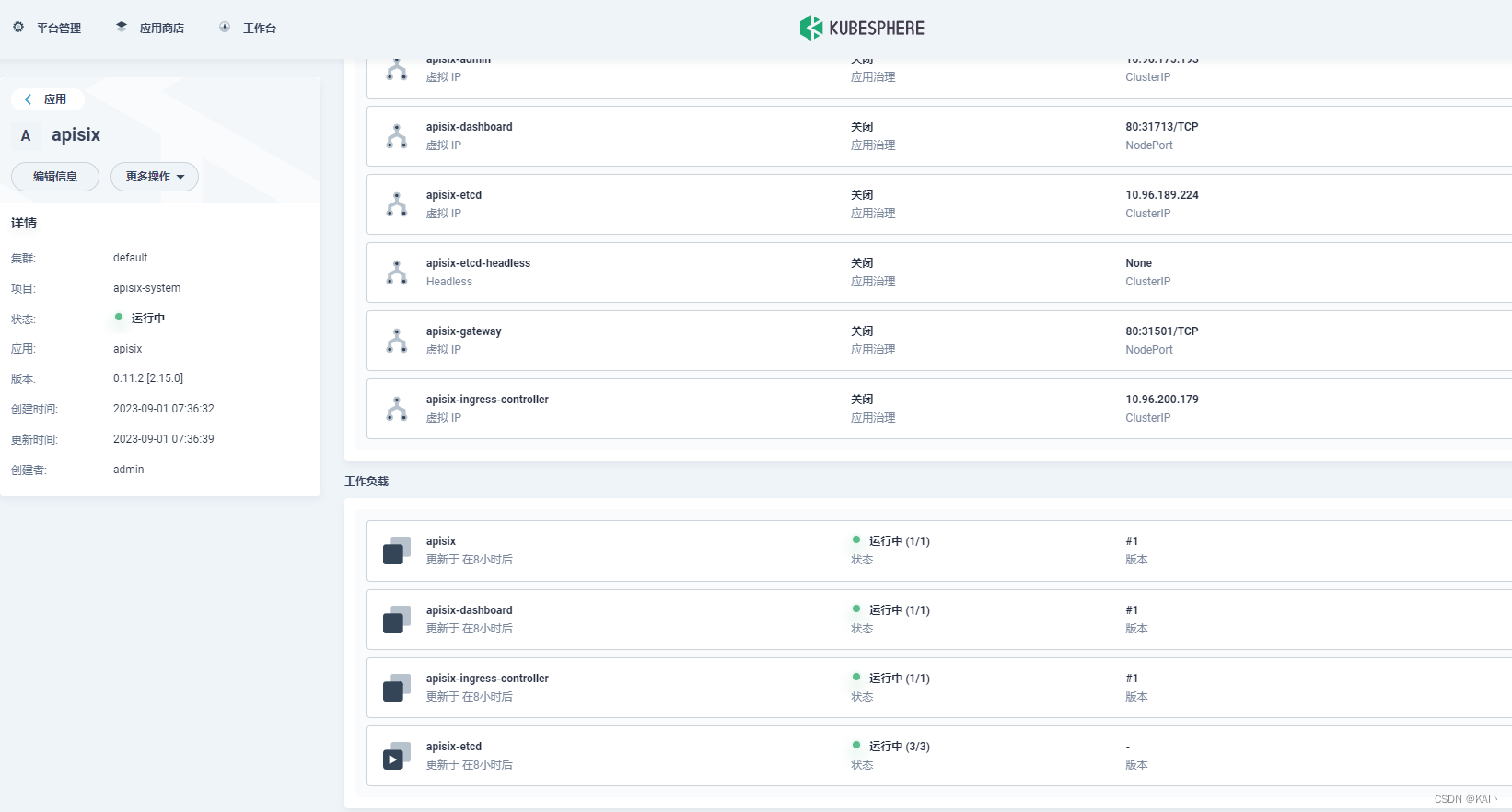
测试访问
测试访问dashboard
查看服务信息

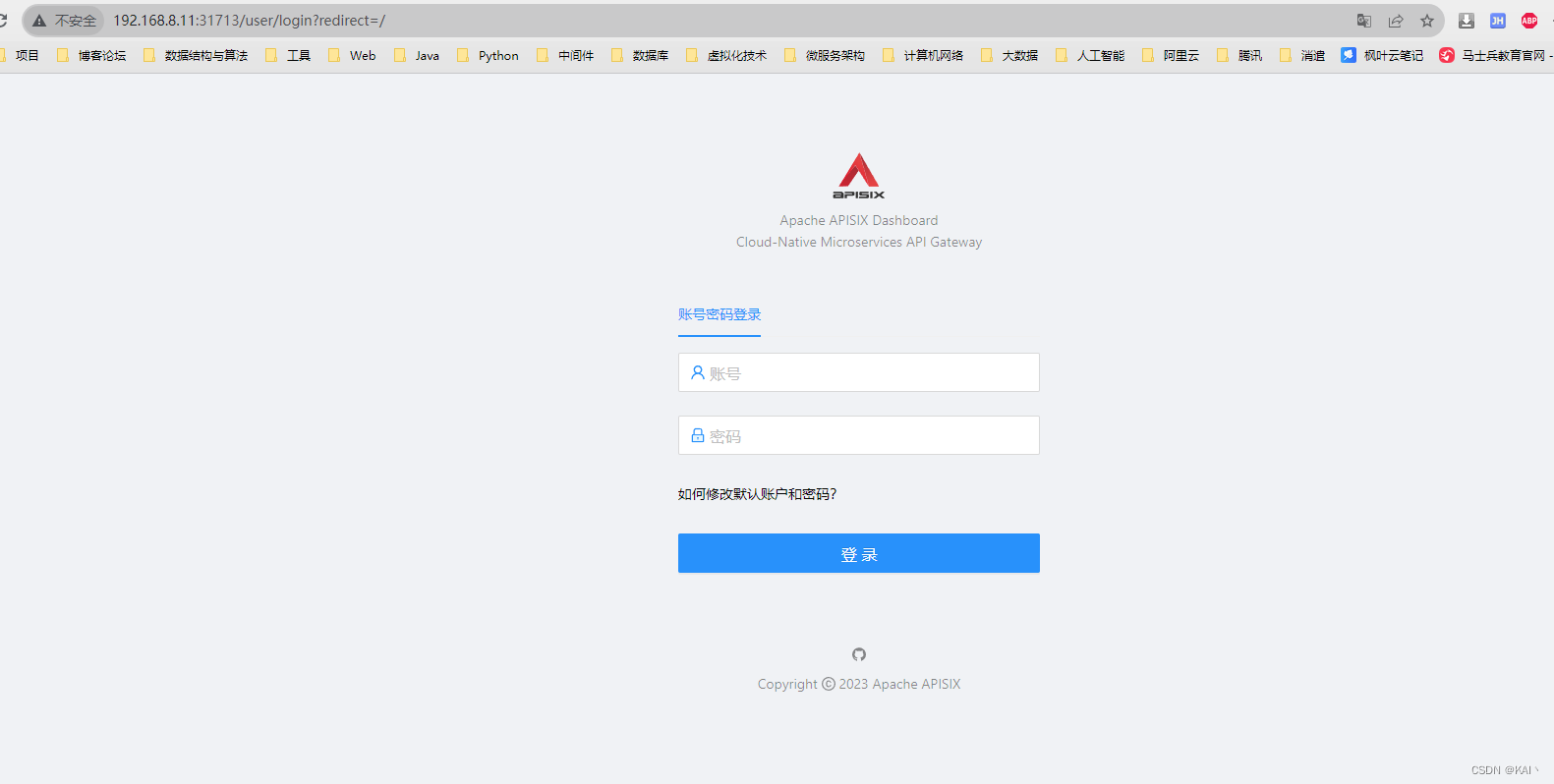
默认账户密码
admin
admin
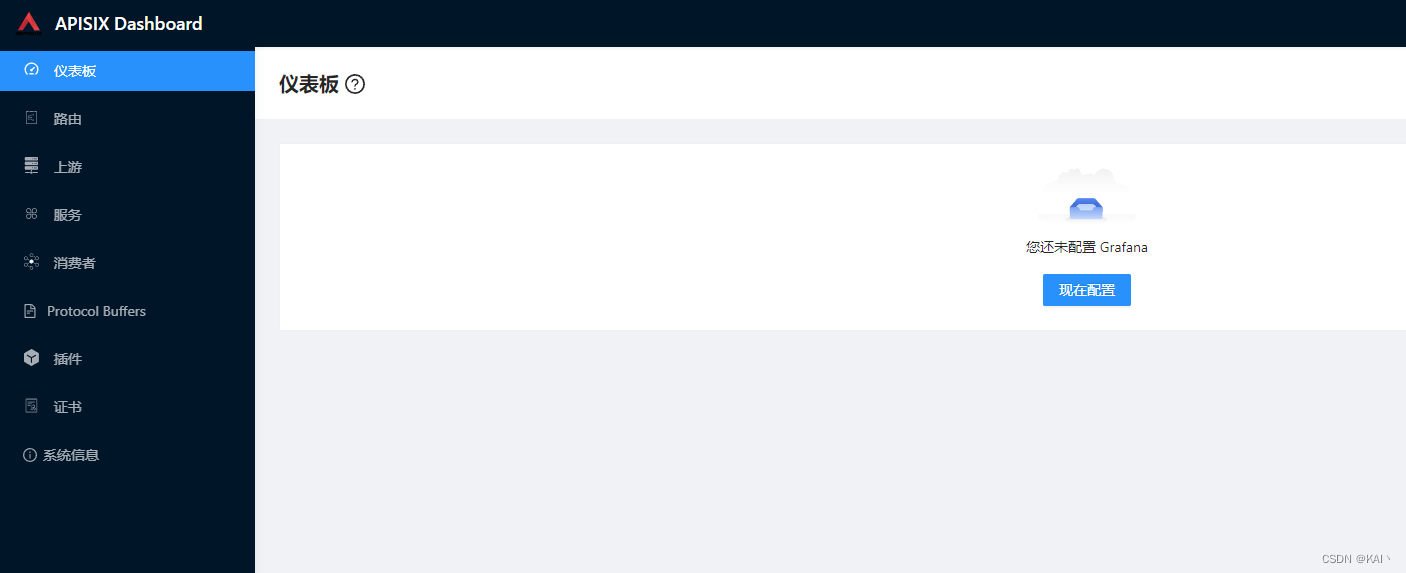
使用apisix
创建两个nginx服务,不暴露外网访问
web-app1
web-app2
#挂载一下index.html文件,或者部署好直进入容器中修改index.html #为了测试apisix网关的效果 #修改一下Nginx中的内容 #进入上面创建的两个服务中 #进入该目录/usr/share/nginx/html #分别修改index.html的内容为 #web-app1.kw.cn #web-app2.kw.cn #进入该目录 cd /usr/share/nginx/html #清空内容 >index.html #没有vi命令,使用追加命令 echo "web-app1.kw.cn" >> index.html #查看是否修改成功 cat index.html web-app1.kw.cn
- 1
- 2
- 3
- 4
- 5
- 6
- 7
- 8
- 9
- 10
- 11
- 12
- 13
- 14
- 15
- 16
- 17
- 18
创建应用路由
上面创建的两个ng服务,这里分别增加对应的应用路由
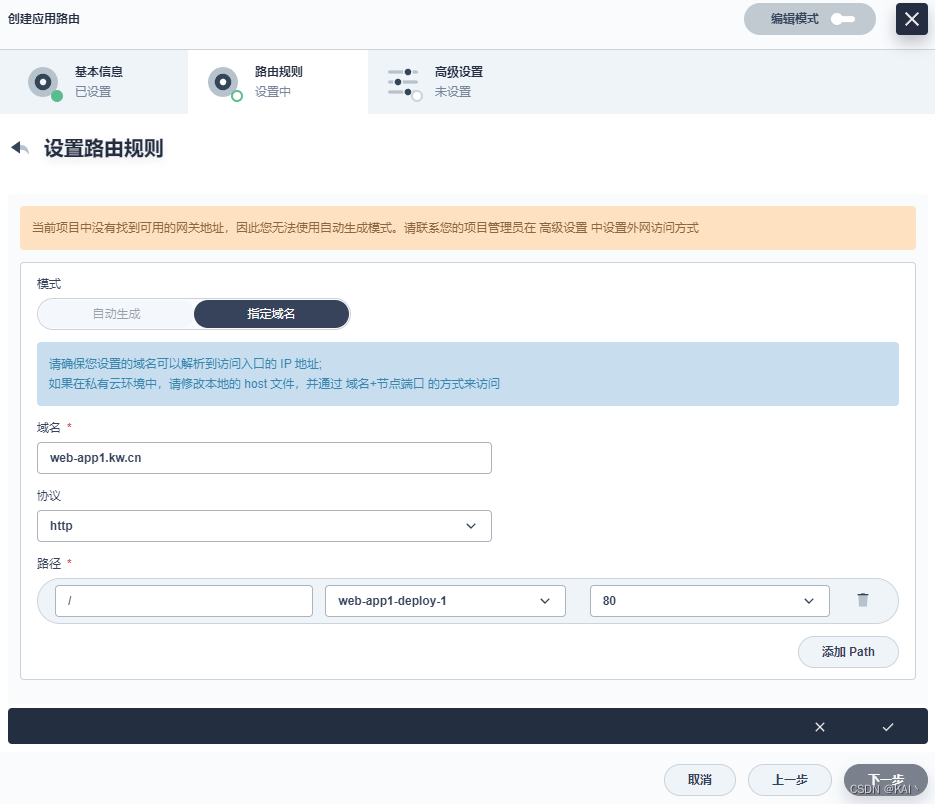
下一步添加元数据注解
#元数据,添加注解
kubernetes.io/ingress.class:apisix
- 1
- 2
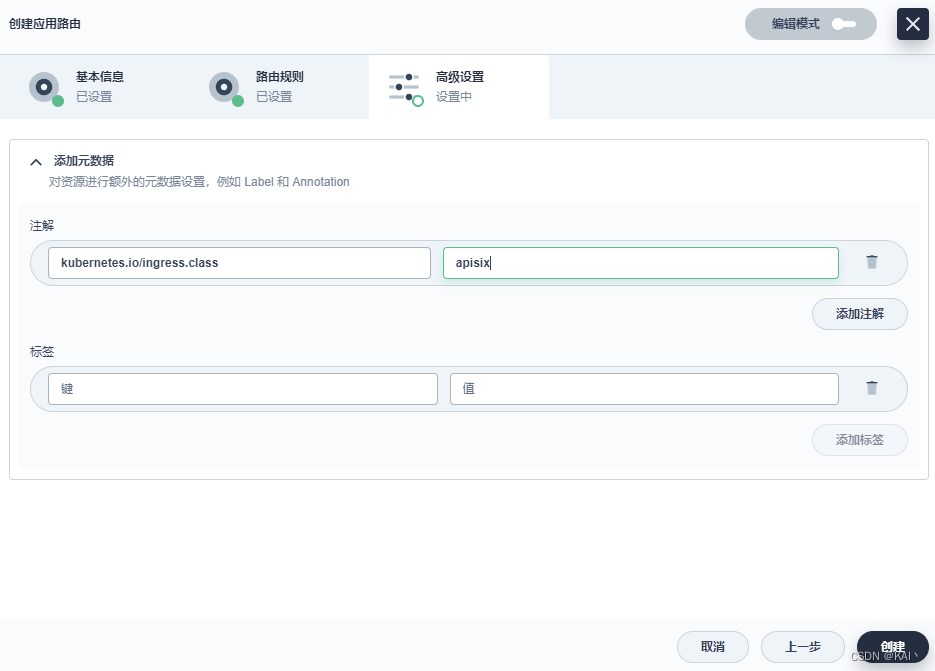
第二个服务同上
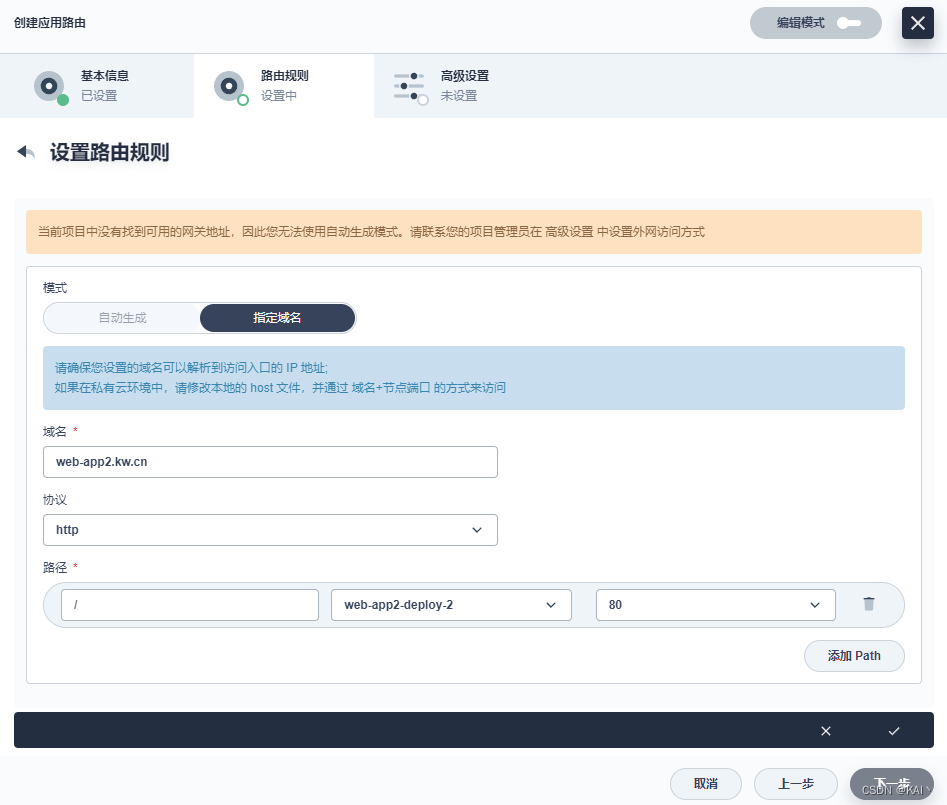
查看apisix dashboard,路由菜单,
可以看到显示了刚刚创建的两个应用路由
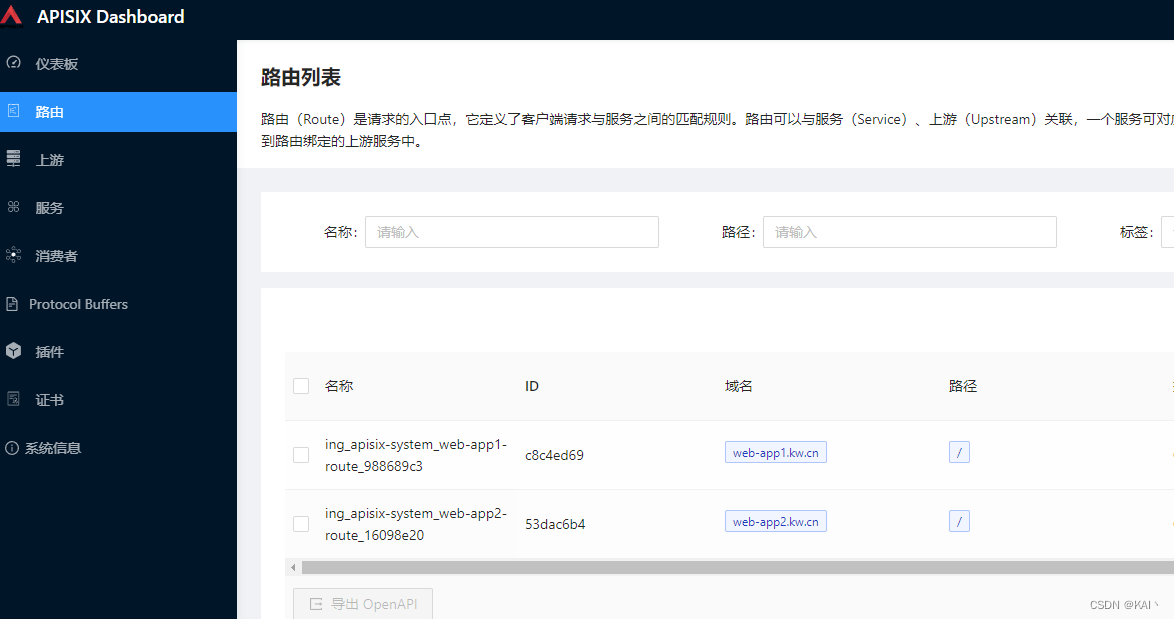
查看网关服务
查看apisix-gateway服务

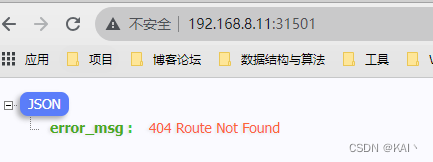
测试效果
#配置域名解析
192.168.8.11 web-app1.kw.cn
192.168.8.11 web-app2.kw.cn


成功访问到了对应的ng服务,说明apisix配置成功。
但不应该携带端口,即应该使用默认端口80,那么就需要调整apisix-gateway的外网访问方式。
使用openelb配置apisix
需要修改这两项,不再使用NodePort方式访问apisix服务

修改apisix-gateway服务
编辑外网访问
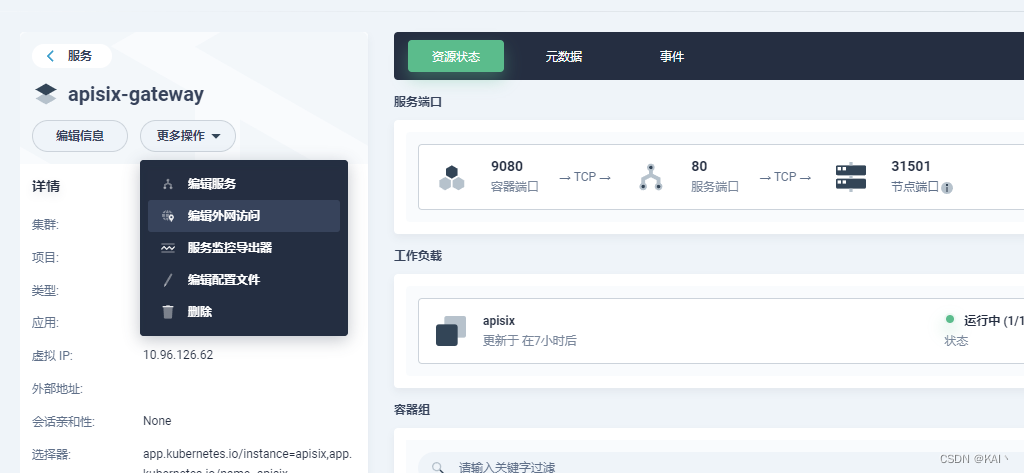
访问方式修改为LoadBalancer
#将下面的键值对填写到注解列表中
lb.kubesphere.io/v1alpha1:openelb
protocol.openelb.kubesphere.io/v1alpha1:layer2
eip.openelb.kubesphere.io/v1alpha2:layer2-eip
- 1
- 2
- 3
- 4
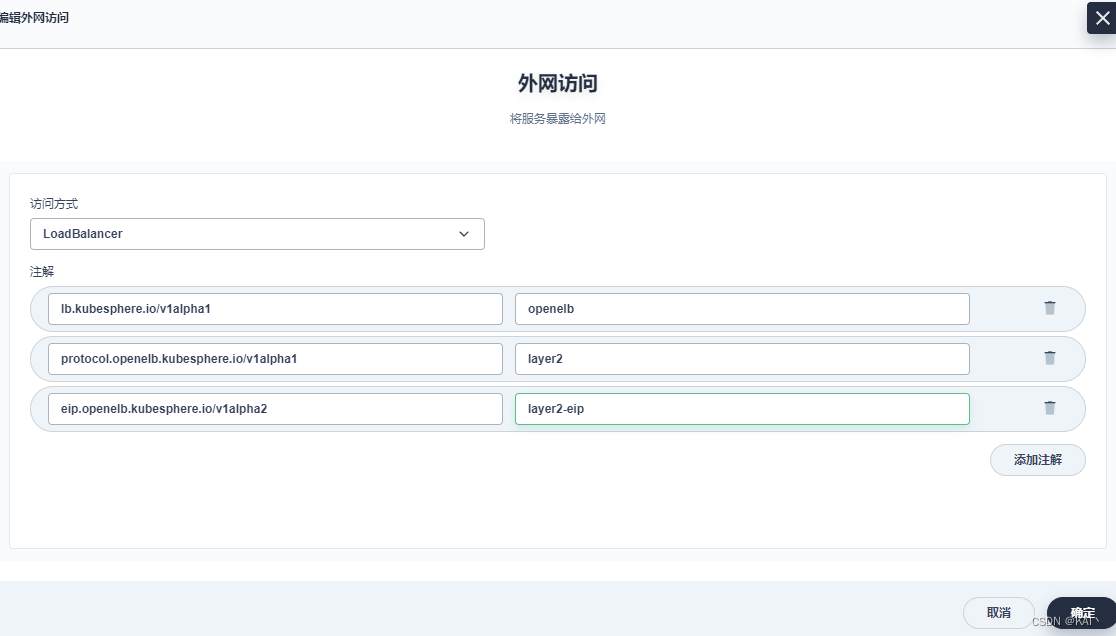
有了外网访问地址
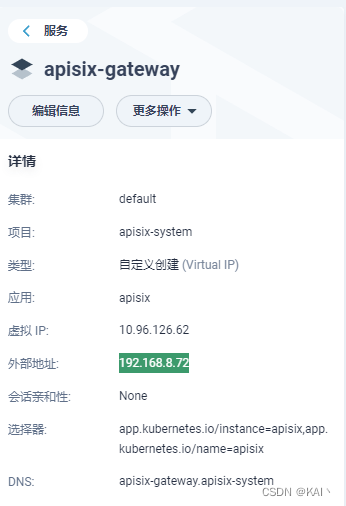
此时,使用80端口,即可访问apisix-gateway

修改apisix-dashboard
同上操作,修改apisix-dashboard
此时,使用80端口,即可访问apisix-dashboard
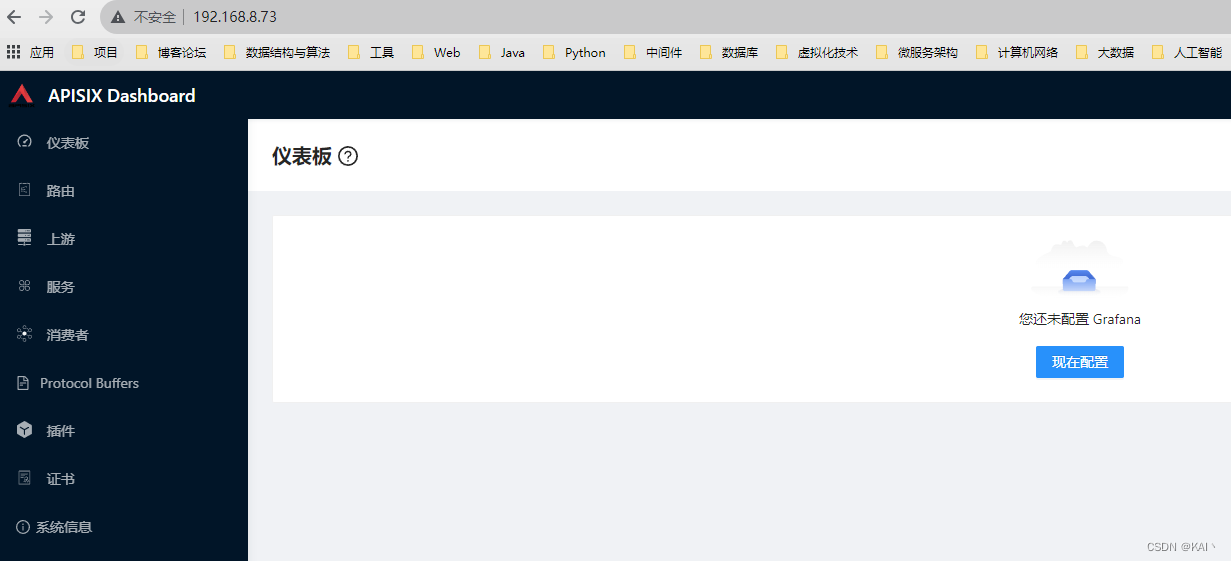
给dashboard创建一个应用路由,配置域名解析
测试访问
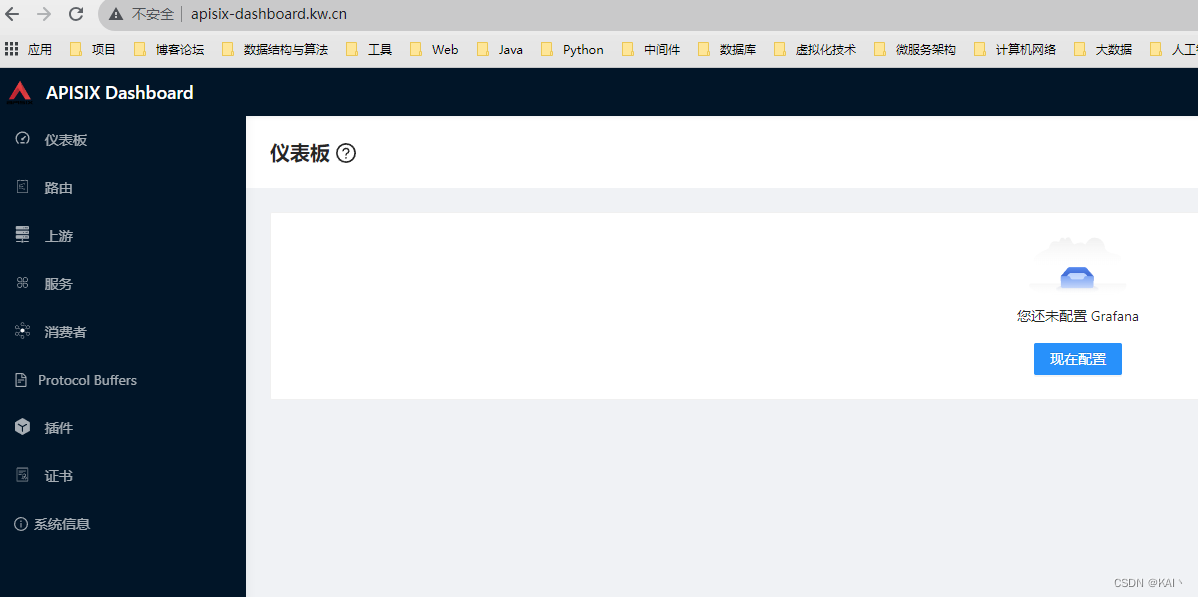
测试访问2个ng服务
配置域名解析,72为上面使用openelb之后,给apisix-gateway分配的ip

测试访问
可以看到不需要携带显示端口就可以访问对应的服务了
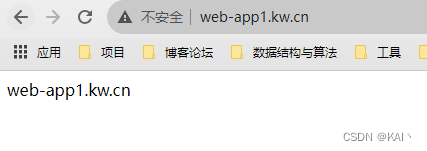
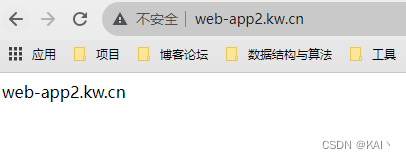
对apisix监控
略,没整好。。。监控不到数据,后续正好补充。


